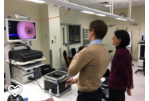
Practicing Bronchoscopy Step-by-Step
During the last decade I committed myself to a philosophical revolution based on the premise that it is unethical for doctors to learn their procedural skills on other human beings. From New York to New Delhi, and on every continent except Antarctica, I have taught that doctors have alternatives to climbing the learning curve patient after patient and, that such alternatives do not need to include animals or expensive cadavers. Computer-based simulation, plastic airway models and more recently, 3D-printer derived airway casts allow bronchoscopists to learn airway and mediastinal anatomy, navigate the tracheobronchial tree, perfect their knowledge of lobar and segmental anatomy, as well as practice the technical dexterity and communication skills needed to perform bronchoscopy safely, effectively, and efficiently.
Not surprisingly, there was some resistance to this new philosophy. Change is difficult, and replacing an age old paradigm built around a purely apprenticeship model (where procedural competency was assumed based on subjective evaluation and an objective enumeration of number of procedures performed), with a new paradigm that includes apprenticeship, mentorship, and several objective measures of learning in a multidimensional instructional program required the support of a growing number of physician experts decided upon becoming themselves agents of change. Today, the idea that patients should not suffer the burdens of procedure-related medical training has caught on. Procedural education is increasingly discussed in our medical societies and university training programs. Simulation centers exist in abundance, although easy and affordable access remains a challenge that must yet be overcome, and physicians everywhere increasingly accept the idea that learning and practicing bronchoscopy in a model must be a prerequisite to performing procedures in a real person.
Like all revolutions, the philosophical must be coupled with the practical. For this new educational paradigm to take effect, therefore, we must improve access to affordable models for all physicians-in-training, as well as for those already in practice who wish to learn new procedures. Objective measures of technical skill, communication, and decision-making must also be incorporated into our training programs. Based on my experience conducting dozens of educational programs around the world, learners enthusiastically accept the idea that technical skill proficiency and a relatively high threshold of cognitive knowledge are necessary before working directly on patients. Hence, it is now our responsibility to provide learners everywhere with these tools, and to engage faculty by sharing content and techniques of multidimensional instructional programs during train-the-trainer programs and on-site courses.
